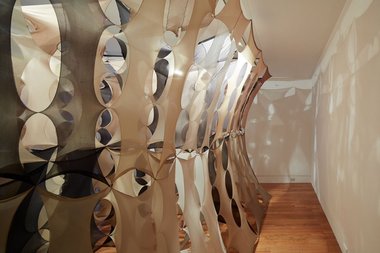John Hurrell – 17 April, 2018
This is a serious project with its beautiful formalism—but grim political subtext—that is in clear contrast to other very amusing works also made by Ezcurra that reference clothing or household drapes. You might argue anyway that there is a malicious pleasure in cutting up pantyhose, to lash out at the male gaze and social expectations to be constantly beautiful (with ‘sexy' legs). That there is vengeful humour in working with these ‘glamorous' stretched nylon pieces—now mutilated and positioned on a ‘torture rack.'
Pakuranga
Maria Ezcurra
Invisible
Curated by Gabriela Salgado
11 March - 22 July 2018
With the spectacular success of Space to Dream: Recent Art from South America at Auckland Art Gallery Toi o Tamaki a couple of years ago, and the inclusion of Trindadian, Tobagan, Colombian, Costa Rican and Puerto Rican publishing organisations in Artspace’s current show, Most Things Happen When I’m Asleep, it is exciting to see Te Tuhi’s new Argentinian art director Gabriela Salgado introduce Aucklanders to the work of Mexican artist Maria Ezcurra.
Though she lives in Montreal at the moment, Excurra‘s work has a distinctive Latin American sensibility, this stretched pantyhose installation possibly alluding to the taut cheesecloth sculptures of Brazilian Ernesto Neto, and the feminist political content of Colombian Doris Salcedo.
For the Bev Smail Gallery in Te Tuhi, Ezcurra has constructed a sort of translucent concave cube that fits snugly in the space, held securely to ceiling and floor with string and eyehooks. It is made from taut nylon pieces from 120 pairs of pantyhose. Their legs seem to have been cut off and the crotch and midriff sections opened out and positioned—with minimal stitching—in a repetitive grid formation on a 5 x 5 floor plan. The result is that you peer through the sheer (brown, beige, charcoal, white and tan skin-coloured) arabesquely distorted material and stacked up oval holes, with gaps halfway up that are also shaped like rows of a horizontal (eyeshaped) vesica piscus. Some sections are frayed like parchment and wrinkled like skin-in fact their shape is reminiscent of flayed hides. The lighting makes the installation dramatic, causing differently toned, overlapping shadows to form delicate mottled patterns on the walls.
With this sculpture you have its highly attractive (extremely ocular) formal qualities of steep curves, overlapping tones, translucent planes and modular repetition. The physical tension of the suspended matrix creates a nice drama. (You wonder: could it collapse before your eyes?) You also have from the nylon material itself, multiple associations with intimate under-garments and the absent female body—a missing presence that is exacerbated in social terms by what is common knowledge about the violent political histories of rightwing totalitarian regimes, and the damaging effects anyway of Latin America’s dominantly macho cultures.
Invisible, the show’s witty title, alludes not only to the ubiquitous negative spaces in the intricate nylon form but also (more obviously) the disappearance of women activists in Mexico, the victims of domestic violence, and the rarely mentioned women who work in garment factories that produce pantyhose. There is a beautiful conceptual circularity referencing the production of the exhibited material, mingled with a chilling reminder of South America’s appalling record of repression, and the brutal, anti-democratic, masculinist forces that seem to regularly run amok.
This is a serious project with its beautiful formalism—but grim political subtext—that is in clear contrast to other very amusing works also made by Ezcurra (see this link) that reference marriage, women’s clothing or household drapes. You might argue anyway that there is a malicious pleasure in cutting up pantyhose, to lash out at the male gaze and social expectations to be constantly beautiful (with ‘sexy’ legs). That there is vengeful humour in working with these ‘glamorous’ stretched nylon pieces—now mutilated and positioned on a ‘torture rack.’
This is a lovely (bodily experiential) show that also provides lots of different interpretative levels for the creative thinker to explore in terms of gender roles, conventions of apparel, democratic processes, manufacturing economies and labour. You can examine the installation and discover various (modernist) optical systems of binary contrast, the way the artist has manipulated and positioned the material, and you can ponder the political implications ideationally embedded in the material as well—narratives of violent repression, exploitation and control.
John Hurrell





 Two Rooms presents a program of residencies and projects
Two Rooms presents a program of residencies and projects Advertising in this column
Advertising in this column



This Discussion has 0 comments.
Comment
Participate
Register to Participate.
Sign in
Sign in to an existing account.